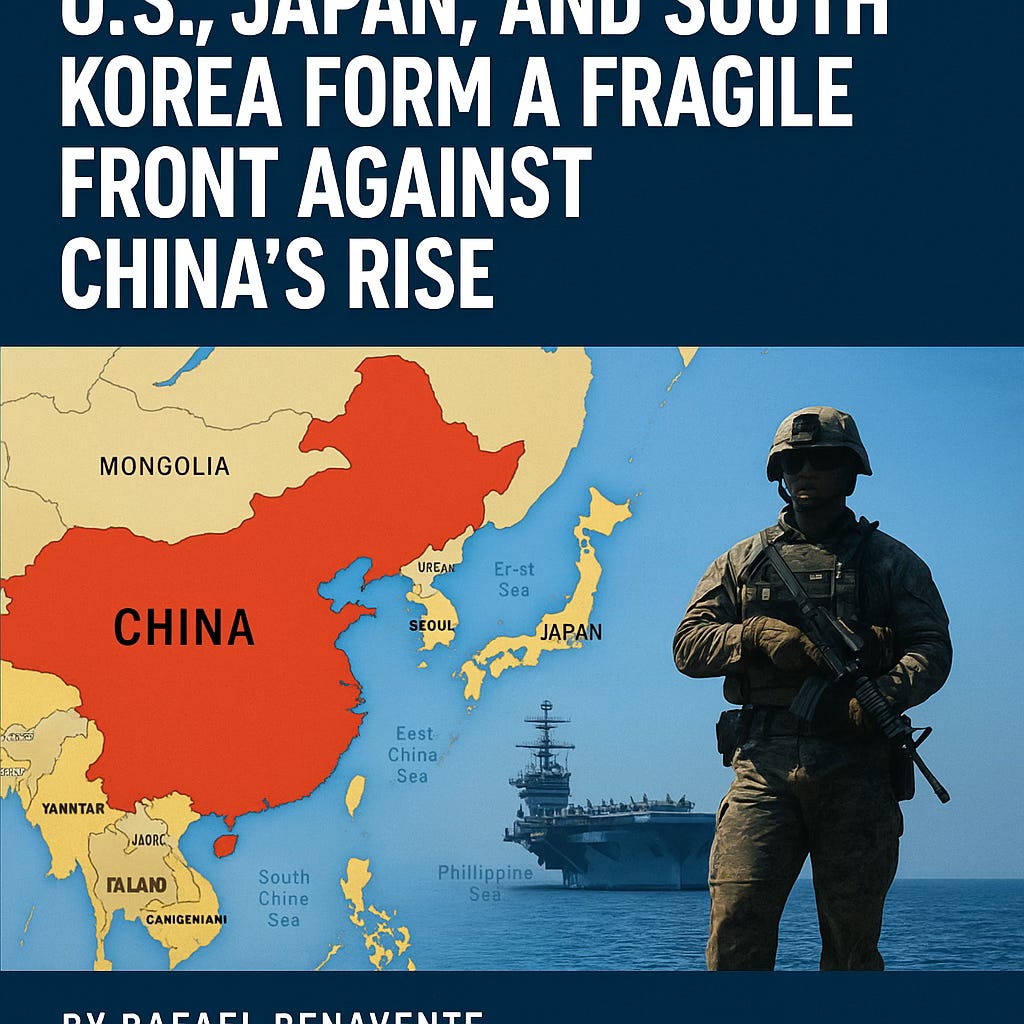East Asia on Edge: U.S., Japan, and South Korea Form a Fragile Front Against China’s Rise
East Asia on Edge: U.S., Japan, and South Korea Form a Fragile Front Against China’s Rise
As the world’s attention remains fixated on Ukraine and the Middle East, another flashpoint is rapidly escalating in East Asia—a region not only vital to the global economy but also deeply vulnerable to geopolitical shocks. Long-standing tensions between China and its neighbors are drawing renewed attention as Japan, South Korea, and Taiwan increase their defense postures, forging closer ties with the United States in a strategic pivot aimed squarely at deterring Beijing’s ambitions.
The Shadow of China: Rising Tensions and Military Spending
China’s assertiveness in the Indo-Pacific has alarmed its neighbors. In 2024, China spent over €200 billion on its military, ranking second globally. With a force of 2 million soldiers, a growing fleet of aircraft carriers, and a projected 1,000 nuclear warheads by 2030, Beijing’s People’s Liberation Army (PLA) is a formidable presence.
President Xi Jinping has signaled that the reunification of Taiwan with the mainland is non-negotiable—even hinting that force may be used if necessary. Taiwan, a democratic island of 23 million people, is strengthening its defenses with U.S. assistance and investing heavily in missile systems and naval readiness.
Japan and South Korea: From Historic Enemies to Strategic Allies
The resurgence of Chinese military power is prompting a historic rapprochement between Japan and South Korea, two nations with a painful legacy of colonialism and wartime atrocities. While tensions remain—especially regarding Japan’s refusal to offer an official apology for “comfort women” and other war crimes—a new generation is pushing for pragmatic cooperation.
On Japan’s remote islands like Okino Rabujima, military drills simulate invasions and emergency evacuations. Surveillance squadrons keep watch over the East China Sea, where incursions into Japanese airspace—mostly by Chinese and Russian aircraft—average nearly two per day.
South Korea, meanwhile, has become a global arms manufacturer and is one of the top 10 defense exporters in the world. Faced with threats from North Korea’s evolving missile arsenal and nuclear ambitions, Seoul is not just modernizing—it is contemplating offensive capabilities that could serve as a first strike in a conflict.
U.S. Presence: The Anchor of Regional Stabilit
y
The U.S. maintains a major presence in the region, with 50,000 troops in Japan and 30,000 more in South Korea. Okinawa remains a strategic linchpin, though it carries deep scars from World War II and significant local opposition to the military buildup.
The First Island Chain—from Japan to Taiwan to the Philippines—is the U.S.’s first line of defense. Bases like Futenma and Camp Humphreys form the backbone of rapid-response operations and coordination hubs with allied forces. Multilateral exercises now include countries such as Germany, France, Australia, and the UK, underscoring the global nature of the threat.
Yet uncertainty surrounds America’s future role. With the return of President Donald Trump, questions loom over whether the U.S. will remain a reliable partner. Japan’s leadership is wary of both potential withdrawal and new demands from Washington.
Taiwan: The Silicon Shield
Taiwan’s value to the world extends beyond geopolitics. The island is home to the world’s most advanced semiconductor firms—TSMC, UMC, and Necronics. Taiwan’s dominance in producing sub-10nm chips has led to the concept of the “Silicon Shield”—the hope that its economic indispensability might deter Chinese aggression.
TSMC has begun diversifying its operations, investing in Japan and other locations to hedge against geopolitical risk. Meanwhile, South Korean giants Samsung and SK Hynix bolster regional semiconductor strength, producing 20% of Korea’s exports and acting as vital nodes in global tech infrastructure.
Ports, Trade, and Global Vulnerabilities
East Asia is not just a security hotspot—it’s a logistical linchpin. Ports like Busan (South Korea), Gaoxiong (Taiwan), and others facilitate more than a third of global maritime trade. Any disruption—military or economic—in the Taiwan Strait or South China Sea would have global consequences.
Chinese state-owned giants like COSCO dominate global shipping and port infrastructure, further entwining China into the global economy. Yet even in places like Busan, contingency planning is underway, anticipating blockades or worse.
Reconciliation and Skepticism at the Local Level
Despite diplomatic breakthroughs, local populations remain skeptical. In Okinawa, where nearly one in four died during the 1945 battle, over half the population feels that the U.S. military presence increases, rather than decreases, the risk of conflict. In rural South Korea, memories of Japanese occupation remain vivid, and relations with Japan remain delicate.
Still, generational change offers hope. South Korean and Japanese students now engage in debate clubs and cultural exchanges, seeing each other as peers rather than adversaries. Former fishers and retired teachers speak cautiously of better ties, hoping history does not repeat itself.
The Taiwan Question: Will It Ignite a Regional War?
Taiwan remains the most dangerous flashpoint. Military analysts believe Japan is more likely than South Korea to intervene in a cross-strait conflict, partly due to proximity and shared threats. However, South Korea remains cautious, with polls showing over 60% of the population opposes military involvement.
Seoul may offer logistical support, but full military engagement remains unlikely. U.S. forces stationed in Korea could still be mobilized, however, adding complexity to the regional security equation.
Conclusion: A Fragile Alliance Under Stress
The alliance between the U.S., Japan, South Korea, and Taiwan forms the bulwark against Chinese expansionism in East Asia. But it is a fragile one, tested by historical grievances, shifting domestic politics, and fears of abandonment by Washington.
As Japan and South Korea rearm and realign, they walk a tightrope between deterrence and provocation. The outcome of this new chapter in East Asia's geopolitics will depend not only on military strength but also on whether trust—both between allies and within their societies—can endure.
By Rafael Benavente


